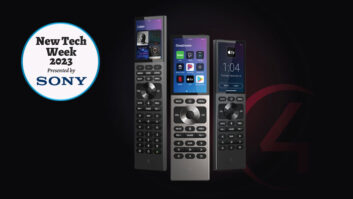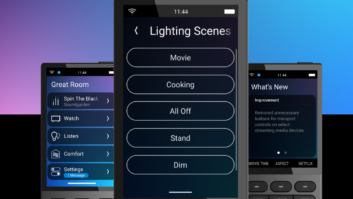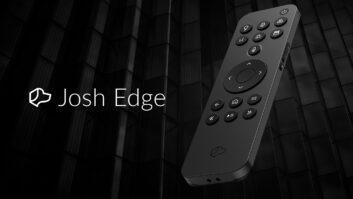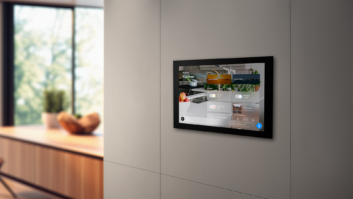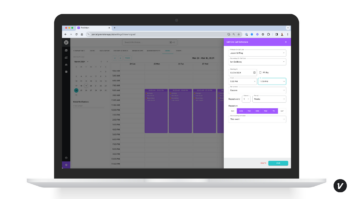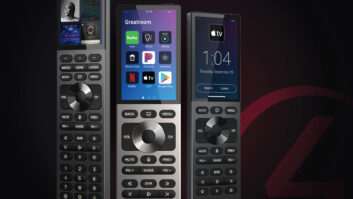This Integration Guide to Remotes and Touchpanels was sponsored by AMX, Crestron, ELAN, RTI, and URC as a supplement to Residential Systems, July 2012.

On the cover: This Philadelphia high-rise features Crestron whole-home control from a TPMC-3SM. The integrator is Creative Systems from Ephrata, PA. Five years ago, the category of touchpanels and remote controls was already in a revolutionary state. Tapping into developing technologies, such as then evolving wireless standards and taking advantage of changing ergonomic tastes, custom integration-grade touchscreens and remotes—already sophisticated in their capabilities—found a captive audience in end users that wanted the latest in control and automation products.
Five years is not a long time, but when it comes to technology of any kind, it can feel like a millennium. Talking with major players in control and automation interface design and development, the words “mobile” and “app” sprinkle every discussion of new products. Indeed, it would be criminal to pretend that the consumer clamor for Apple- and Android-supported mobile and tablet technologies have not exerted considerable influence on custom integration touchpanels and remotes. With consumers’ muscle memory currently dictated by swipes and slides on tiny touchscreens, integration-grade product manufacturers, without much hesitation or resistance, have chosen to marry their products with the pocket-sized devices that are redefining how consumers interact with everything from friends to thermostats.
“Over the last few years, there has been an overwhelming demand by consumers for control over their electronic systems via smartphones and tablets,” noted Pete Baker, vice president of sales and marketing for RTI. “And while we at RTI don’t believe that these devices should serve as a replacement for dedicated handheld controllers, we do feel that they provide a number of benefits when used in conjunction with the primary control system, particularly when it comes to remote access.”
While it is clear that the influence of mobile applications and devices have dominated the conversation, as well as custom design plans, dedicated touchpanels and remotes do deserve to regain some of the spotlight—a point that is lost on no one who plays in the field. The crop of touchpanels and remotes currently serving the custom channel, while taking cues from their newborn mobile siblings have also done some growing up of their own.
Interfacing at the Fore

AMX’s Modero X series of touchpanels incorporate multitouch and gesturing capabilities as well as integrated voice and video communications.
“Five years ago, most of our remotes were hard-button-oriented with monochromatic screens, and were focused on providing the best home theater and AV control experience,” said Cat Toomey, director of marketing for URC. “Since then, we’ve added remotes with full-color LCD and OLED screens, touchscreen remotes (tabletop, in-wall, wand remotes), two-way control functionality, and more. And we’ve been able to produce the best in control solutions while meeting the price levels that the market and consumers demand, especially now that people have become more aware of home control and more technology options are available.”
In addition to now-ubiquitous iPad integration, URC has added a whole-house control system, Total Control, to its line, as well as IP network communication to many of its new remotes and controls.
Toomey noted that because URC’s product line is “stacked from top to bottom” the manufacturer’s dealers have good/better/best solutions to draw from when prepping installations.

Of particular pride forControl4 has been theaddition of the Control4 7-inch portable touchscreen with camera and the 7–inchin-wall touchscreen with camera, both of whichprovide dedicated, always-oncontrol functionality and a high-quality communication experience for homes and businesses.

At Crestron, touchscreen sales are up, according to director of architecture and design, John Pavlik, because “people are more interested in technology as a whole.” Addressing the fundamental challenge of making an intuitive touchpanel that is efficient, Pavlik pointed to Crestron’s investment in its Core 3 UI platform.
“One of the benefits of that platform is it allows us to create smart objects which can be used to combine elements in an interface into one object that somebody can use to create an interface,” Pavlik said. “For example, somebody can create a videoconferencing page; there might be multiple buttons to put on the screen and sliders to control volume. Now we are able to create a VTC (video teleconferencing) object that gets dropped on to the panels.”

Addressing the fundamental challenge of making an intuitive touchpanel that is efficient, Crestron has invested in its Core 3 UI platform, which allows dealers to create smart objects that can be used to combine elements in an interface into one object that somebody can use to create an interface.
That mobile muscle memory mentioned earlier has had an influence on AMX’s Modero X series of touchpanels. Incorporating multitouch and gesturing capabilities, as well as integrated voice and video communications, the Modero X has benefited from the feedback of user experience consultants that were instrumental in helping to create “a more intuitive user interface design that allows anyone, no matter their technical background, to control a home full of technology,” said Shaun Robinson, director of product management for the company.
“Our focus on unique industrial design and usability features have assisted our integrators in differentiating our touchpanels; this along with the benefit that they are optimized for control and collaboration from consumer devices,” Robinson added.
In the same spirit of consumer device collaboration, RTI has developed, in addition to the RTIPanel app for mobile devices, the SURFiR companion remote, which allows homeowners to use their Apple and Android devices as the main graphical interface for their control system with the addition of tactile, hard buttons. “By doing so,” Baker said, “it overcomes the many of the limitations of using a smartphone or tablet as a primary controller.”

Gathering together the best features of its previous touchscreen iterations, ELAN Home Systems pointed to its TS series that now offers full home control, surveillance video monitoring, and access to data and features, with the 10-inch models featuring analog video for watching television.
Baker, who is adamant that dedicated handheld and in-wall controllers are still the focus of not only RTI but the custom integration industry as a whole, makes clear that if a client wants to control their system via a smartphone or tablet, RTI integrators can offer a solution that is both elegant and responsive to mobile devices, with a follow-up recommendation that the client use this interface to support a dedicated touchpanel device—a more practical solution for local control of the handheld remote,” Baker explained. “If the integrator didn’t have the app and told the client that they needed to use a dedicated controller, the client could easily become fixated on the interface and move on to another integrator that provided it.”
Gathering together the best features of its previous touchscreen iterations, ELAN Home Systems pointed to its TS series that now offers full home control, surveillance video monitoring, and access to data and features, with the 10-inch models featuring analog video for watching television.
“We designed our new touchscreens’ sleek, flush profiles to match the aesthetics that interior designers, architects, and homeowners appreciate,” said Joe Lautner, manager of business development and project management for ELAN. “Several models incorporate hard buttons for instant access to control volume, lights, and more. All of our touchscreens also have a microphone and speakers that enable intercom and communication features. Providing pleasing aesthetics and increasing screen sizes for aging eyes were both big influences in our latest designs.”
Citing these new attractive aesthetics and capabilities that are not possible on mobile devices, Lautner said the company’s tabletop touchscreens, notably the TS10 and the TS7 touchpanels, have been a big hit in bathrooms and kitchens, while the TS2 that is often used in hallways, living rooms and bedrooms have enjoyed similar popularity.



RTI has developed, in addition to the RTIPanel app for mobile devices, the SURFiR companion remote, which allows homeowners to use their Apple and Android devices as the main graphical interface for their control system with the addition of tactile, hard buttons.
Gary Hansen, senior product manager of Control4, along with his colleague CTO Eric Smith, is not shy about the evolution much of the company’s touchpanel products have experienced over the years. The litany of transformations includes the addition of capacitive touchscreens, the doubling of battery life, the halving of product size for the same size screen, the creation of low-profile wall mount options, doubling wireless speed, and added features like an H.264 video intercom with high fidelity wideband audio and beam forming microphones.
“The capacitive touchscreens alone have had a monumental impact on touchpanel design as Control4 led the industry by more than a year with this asset seen in our line of Infinity Edge touchscreens,” Smith said.
Of particular pride for Control4, however, has been the addition of the Control4 7-inch portable touchscreen with camera and the 7–inch in-wall touchscreen with camera, both of which provide dedicated, always-on control functionality and a high-quality communication experience for homes and businesses.
“The solution is much easier to utilize and incorporate within an installation than it was in the past, where integrators had to try to combine these technologies manually and try to program them to work together, ” Hansen noted when asked about the benefits of the new video intercom products to integrators.
At Vantage Controls, Andrew Wale, the company’s vice president of marketing, said that the new Equinox touchpanels are set to replace the company’s previous touchpanels, which have been in commission for nearly 10 years. Equinox features are set to include a single layer, programmable interface with a resistive touch LCD to further simplify operation.
“The biggest influence over the last three to four years on touchpanels has been the advent of the iPad both from a cost and usability standpoint,” Wale said. “This has increased the customer requirement, but at the same time LCD panel performance-to-cost ratios have improved. Our new line of interfaces to be released over the next year, beginning with Equinox control in September, will offer both improved cost and usability.”
Savant Systems is a unique player in this market. From its inception, the control company has based its touchscreen and remotes on the Apple operating system and has greatly benefited from the boom in popularity the Apple iPad has enjoyed for the past few years.




With more than 10 choices of faceplates and a fully customizable GUI, HAI’s Touchscreen is popular among HAI integrators. The company’s apps for touchpanels are also proving to be a firm choice among homeowners.
“The proliferation of Apple’s iOS devices has provided Savant with interface options that are powerful, versatile, and reliable—and best of all, nearly everyone uses them in their daily life and has attained a comfort level with how they operate,” said Jim Carroll, executive VP of the company. “The iPad, iPhone and iPod touch are the ultimate control and automation user interfaces, and Savant offers brackets for wall mounting the iPad in both portrait and landscape applications.”
Savant has not neglected its dedicated product arsenal, however. Acknowledging market demand, Carroll said that in addition to desktop docks, the company also has a remote control—the Savant Select—that delivers “the hybrid capabilities of a touchpanel and simplicity of traditional hard buttons” and features an embedded iPod Touch flanked by familiar navigation buttons for operation of local TV and cable boxes.
With a history as a third-party developer of hardware and software for custom integration manufacturers, as well as honing its own brand of touchscreen products, HAI has had a unique perch in the industry.
“Five years ago, like many manufacturers, HAI was deep in development of our own wired and wireless touchscreens,” said Greg Rhoades, associate director of marketing for HAI. “We spent lots of time selecting proper hardware components as we watched and helped the market develop. Now, everyone has a wireless touchscreen in their pants pocket or purse, so we design with that in mind.”
Rhoades noted that many homeowners now will place one or two hardwired touchscreens in a house and then let everyone control from their wireless devices. “Before, we saw installations with a dozen or more hard-wired touchscreens as a common installation practice,” he said.
With more than 10 choices of faceplates and a fully customizable GUI, HAI’s touchscreen is pretty popular among HAI integrators, according to Rhoades, who added that the company’s apps for touchpanels are also proving to be a firm choice among homeowners.
“No licenses or monthly fees are required,” Rhodes explained.” Buy the app, put it on your device, and you’re good to go! Another reason why these mobile devices are so important to home automation: We’ve been able to strip functionality out of our full system and offer these as standalone solutions. For instance, if the homeowner only needs AV controls, we provide a black box, and they provide the interface for our app, reducing costs exponentially.”

In addition to now-ubiquitous iPad integration, URC has added a wholehouse control system, Total Control, to its line, as well as IP network communication to many of its new remotes and controls.
Staying in Touch
For manufacturers of touchpanels and remote controls, the dedicated interface is not a thing of the past, though how it will look and feel will certainly change—something that is already underway if we are to place mobile devices squarely in the picture. Having embraced mobile devices as counterparts and pitching partners, manufacturers are showing that they are open to what these newer devices can bring to their own products without supplanting them altogether.

Equinox touchpanels are set to replace Vantage Control’s previous touchpanels, which have been in commission for nearly 10 years. Equinox features are set to include a single layer, programmable interface with a resistive touch LCD to further simplify operation.
Though the next five years are not easy to predict, we can be sure that technology science—here referring to everything from hardware-less, gestural inventions to interactive holographic interfaces—will have a place in the custom integration business. Sure footing has already been established with a noted history of innovation in our niche market. It’s just a matter of stay next to and, when at all possible, ahead of the game.
Llanor Alleyne is a contributing editor to Residential Systems, based in Brooklyn, NY.
Robert Gilligan

Engineered Environments, Alameda, CA
How are you using touchpanels/remotes to outfit your control projects?
Remote controls are used in every television location and with [Control4’s] on-screen navigator, we are able to provide a wide-range of users (homeowners, family, and guests) a hospitality-like user experience. We use touchpanels sparingly in control-heavy locations (for example; the kitchen, front door, garage door, night stand). These locations offer our clients easy access to whole-house automation features like welcome-home or goodnight settings that align with their lifestyle. The kitchen touchpanel is a control hub for the family, but also the central point for audio content selection. It ends up being used more than any other touchscreen in the house and in our opinion, the most important.
Dick Rozic

Aveon Inc., Houston, TX
How are you using touchpanels/remotes to outfit your control projects?
The highest impact locations for touchpanels are in the kitchen and master bedroom. The kitchen is the crossroads for all home activities and the Control4 touchpanel gives our clients simple control over whole-house music, lighting, and thermostat control. In the master bedroom, we can eliminate a lot of wall clutter with a touchpanel. The homeowners can easily shut down the house from their master; from one device they can turn off lights, set thermostats, check cameras and make sure the kids’ TVs are all off. You can do all these functions from an iPad or Android tablet, but there’s something convenient about a wall-mounted device; it’s always there and always on and connected.
Craig Brayman

Future Home Integration, Clermont, FL
How are you using touchpanels/remotes to outfit your control projects?
At Future Home Integration, we’ve utilized RTI control solutions in a wide variety of challenging installations, from large commercial projects to yachts and motor homes. There was one project where we needed to create a “home control center” for a client’s home that was not wired for an integrated system. Basically, we had to get creative. And we did using RTI’s T3-V+ touchpanel controller, an iPad and iPhone with the RTiPanel app, and a PC with RTI’s Virtual Panel control interface. From any of these interfaces, the client can view their surveillance cameras, open and close their front gate and garage with visual feedback for confirmation, monitor their security system zones for activity, and control their lights. In addition, we were able to create control schedules. For example, the client didn’t want the gate code that the pool and lawn service personnel use to be functional 24/7. With control schedules, the codes only function during certain hours, and if someone tries to use them outside of those times, an alert email is sent to the client.
